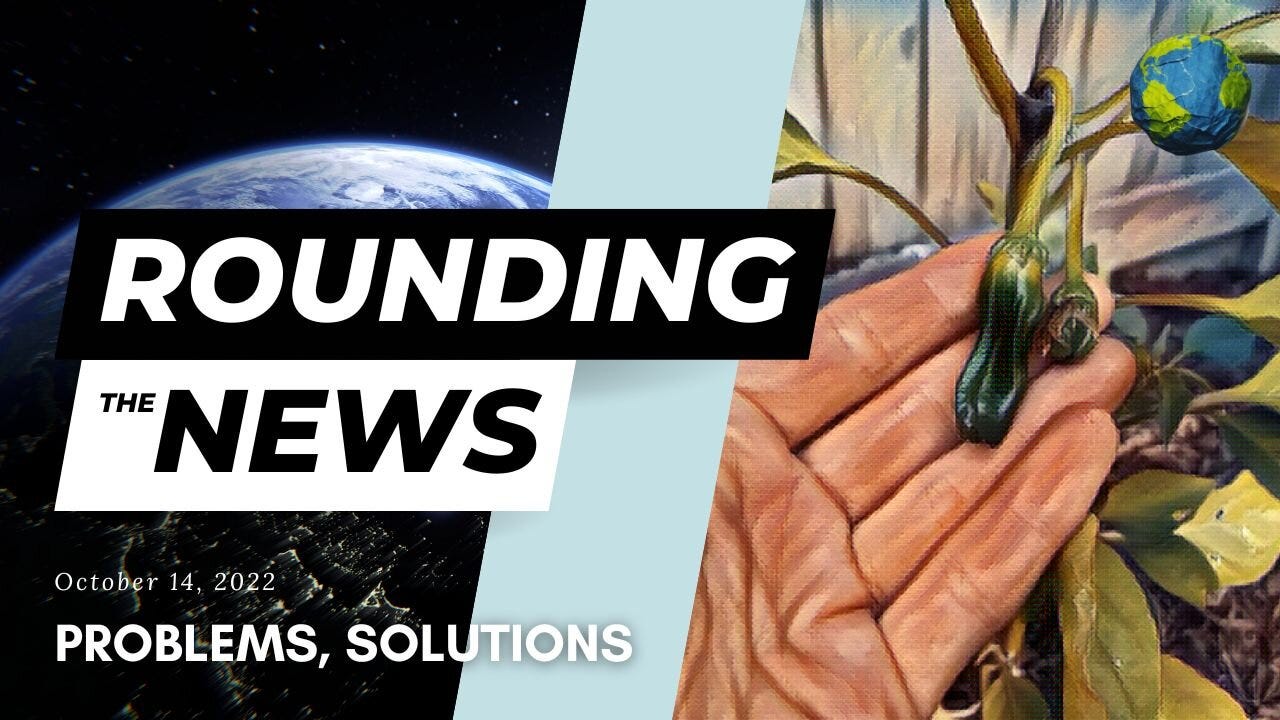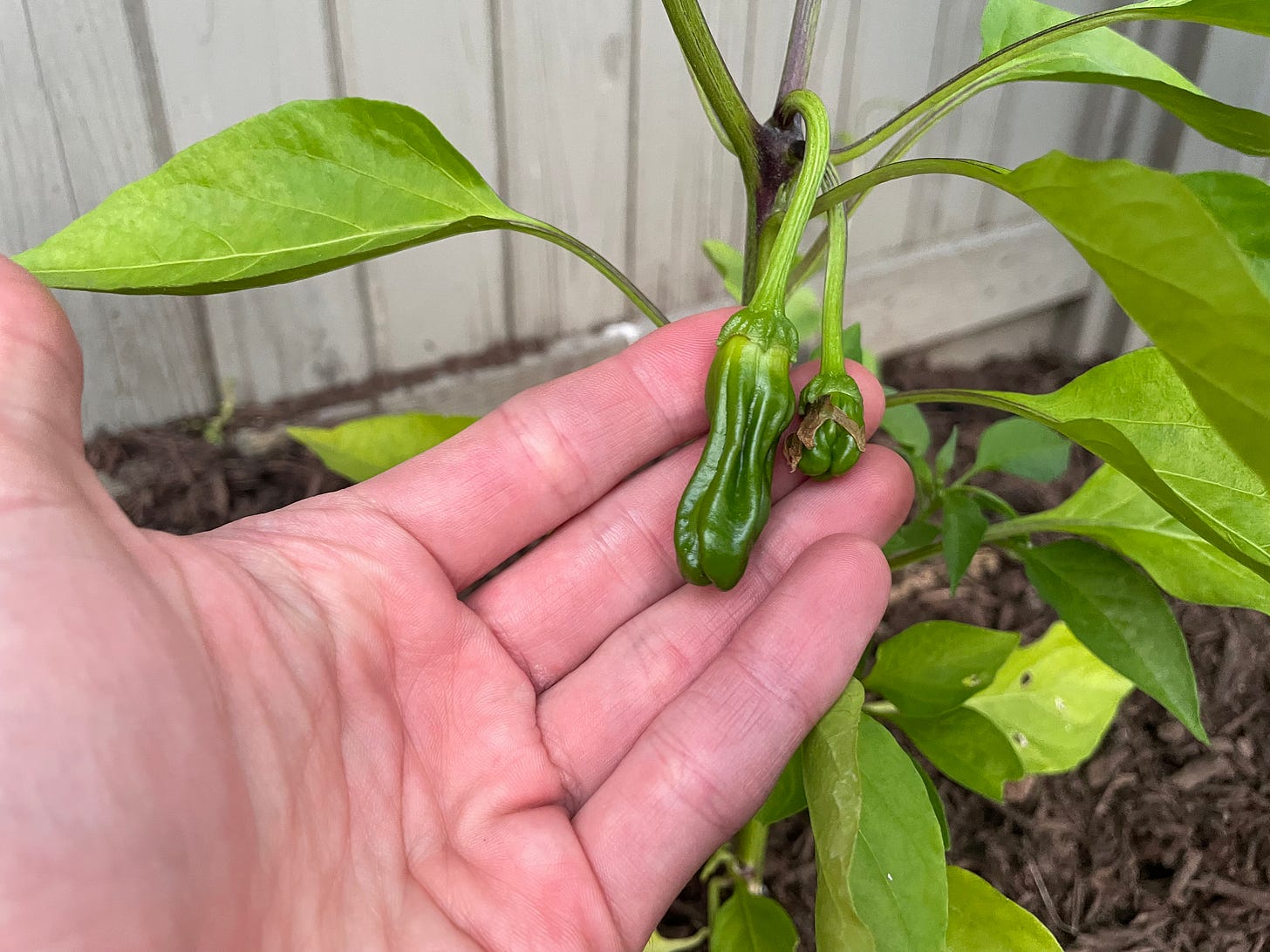Problems, Solutions
Leaked hospital numbers, Danielle Smith, gardening, WWIII, and emojis
Welcome back to Rounding the News, your weekly news roundup presented by Rounding the Earth. I am your host, Liam Sturgess, and I look forward to sharing with you some of the things I found to be most interesting and important over the last week. As a reminder, you can support the show during the livestream by sending us a Superchat on YouTube, a Rumble Rant on Rumble, or a tip on Rokfin.
Let’s jump right in.
Health: Hospitals were bad before - apparently they’re even worse
Law: New Premier Danielle Smith plans to update human rights code
Economy: One third of households are suffering financially
Geopolitics: France doesn’t want World War III
Environment: Meet the “Ridiculously Resilient Ridge”
Culture: Don’t use this emoji, says thought police
Health
It’s been a few weeks since we last checked in on the state of the health care system around the world. Let’s kick off our show today by seeing how hospitals are doing in this “post-pandemic” world!
Ontario hospitals are even worse off than admitted
…okay, so not good.



According to CityNews, documents leaked by Ontario Liberals show that actual hospital wait times in the province were even worse than previously thought.1
“This summer, dozens of hospitals in the province were forced to close their emergency rooms, beds or ICUs because of critically low staffing levels. The Canadian Union of Public Employees (CUPE) recently said people who call 9-1-1 are waiting longer for an ambulance to arrive because paramedics are spending more time offloading patients than responding to emergencies.”
As can be expected, Liberal Member of Provincial Parliament (MPP) Dr. Adil Shamji blamed Premier Doug Ford and his deputy for the crisis. Ford’s Ministry of Health fired back, pointing out that the healthcare crisis we’re seeing now is only the breaking point of a much longer crisis overseen by the Liberal party. Ford is the leader of the provincial Progressive Conservative party.
Let me be clear, folks: it’s bad. In the early afternoon yesterday, Glengarry Memorial Hospital in Alexandria, Ontario announced it was closing at nighttime over the weekend.2

Situation is “difficult and busy” in the UK
Meanwhile, in the United Kingdom, our British friends are experiencing limits on hospital care too. Queen Alexandra Hospital is redirecting all its resources to its emergency department, telling non-urgent folks to steer clear.3 This was done become demand for emergency response is apparently "far outstripping" capacity. No word in this article as to what is causing so many sudden health emergencies.
Unexpected deaths continue to pile up
Despite the lack of clarity and the wide variety of possible causes, it very much seems as though deaths of strange circumstance continue to pile up. Here are some examples:
A patient at Penticton Regional Hospital's psychiatric unit in Penticton, British Columbia died this week without explanation, and no apparent cause at this time;4
Children suddenly suffering their own version of “collapsing athletes” while playing video games;5
Two “sudden” unexplained deaths within a week in Ireland: Aaron O'Neill and Charlene Morrison.67

I do not assert these are related to any particular cause. I do, however, join the chorus of calls for a robust investigation into why hospitals are more full now than ever, and why so many people from baby to elderly are suddenly dropping dead as a matter of habit. Call me overbearing.
Law
Danielle Smith elected Premier of Alberta

Late last week, I received a flurry of messages from my fellow Canadians informing me the new Premier of Alberta was about to be announced. The excitement was palpable, as it was quite clear who was going to win. Lo and behold, Danielle Smith took home the day and replaced outgoing Premier Jason Kenney.8
While some might say anyone would be an improvement over the incumbent, Smith has been a vocal critic of Canada’s COVID-19 “public health” policies and has clearly indicated she would work hard to undo the damage done. The day she was sworn in, she called for “vaccine choice” to be clarified as protected under the Canadian Human Rights Act (which it already is, by the way.)9 She also announced plans to fire Alberta’s Provincial Health Officer Deena Hinshaw.10

Predictably, this immediately landed Smith in hot water. As widely shared on Twitter:11

Of course, Smith’s statement is being twisted and misrepresented - at least, in my opinion. Watch the entire video. This is what she said:
“The community that faced the most restrictions on their freedoms in the last year were those who made a choice not to be vaccinated. I don’t think I’ve ever experienced a situation in my lifetime where a person was fired from their job, or not allowed to watch their kids play hockey, or not allowed to go visit a loved one in long-term care or hospital. Or not allowed to go get on a plane to either go across the country to see family or even travel across the border.
So they have been the most discriminated against group that I’ve ever witnessed in my lifetime. That’s a pretty extreme level of discrimination that we have seen. I don’t take away any of the discrimination that I’ve seen in those other groups that you mentioned. But this has been an extraordinary time in the last year in particular. And I want people to know that I find that unacceptable. We are not going to create a segregated society on the basis of a medical choice.”
But you can’t fit all that in a Tweet. In fact, you can’t fit anything nuanced in a Tweet. The sad fact is that most people have probably never heard from Danielle Smith before until this clip went viral, especially young people, and if all they see are one-line selections combined with contrived interpretations, we will have a false reality on our hands. Note that in the above Tweet, Courtney Theriault says that Smith claimed “unvaccinated people have suffered greater discrimination than those based on race, gender, sexuality and other.”
No, she didn’t.
I don’t claim to know Smith very well at all, so I can’t speak for her any further than what I see and understand. It’s possible she has said other things that I will later find problematic. But in the meantime, this clip has been so severely misrepresented that Smith released a follow-up statement to clarify what she actually said, and added a caveat that may have been worth including from the get-go.12
In reality, she essentially repeated what she said before, but emphasized something I believe strongly: groups of people have been systematically and rotationally oppressed for centuries, with different attributes defining the oppression at a given time. All discrimination is bad, and all discrimination should be the focus of our attention. Just because a new group is being put in the “discrimination spotlight” does not then suggest other historically oppressed groups are no longer in the picture. That’s absurd.
Further, this “unvaccinated” population is not limited to any given colour, sex, religion, nation of origin, language, gender, sexuality, or age. It’s just people. A medical decision is not trivial, and millions of people in Canada alone have been subjected to tremendous hatred for making a different choice for their own body.
Alas, the falsehoods carry forward, such as this headline in The Globe and Mail.13 She did not "walk back" her comment. She had nothing to walk back.
This is perhaps a reminder that those with the loudest megaphone - who also partake in the censorship of opposing views - are not the majority. Smith was elected because a majority of people in the Province wanted her. Let’s hope she follows through on her promise to treat all Albertans as equal under the law and in society, undivided by any personal attribute.

Solutions
Last week, one of our viewers suggested that instead of dwelling on problems, I also emphasize solutions. While I admit I felt immediately defensive - after all, knowledge is power - I very quickly understood this to be a request based out of a very real sense of anxiety around our situation.
No matter where you are on the Earth, you’re facing the same fundamental challenges of food security, wealth creation and protection, individual liberty, freedom of speech - the list goes on. As we wade through this set of problems, we as individuals will respond differently and generate creative and unique solutions based on who were are and external factors. In that sense, we can share what we’ve learned and applied to our own lives in order to provide more tools to the global community. That way, we can begin to rebuild our reality of wellbeing and personal sustainability outside the system trying to sacrifice us in the name of its sustainability.
Let’s start here: vote out your incumbents. I had a lovely four-and-a-half hour lunch with Karl Harrison, who you may remember from our Round Table discussion exactly one month ago.14

I asked Karl for advice on how to approach choosing who to vote for in our upcoming General Elections here in West Vancouver.15 After a cursory glance at the candidates, I was disappointed that none appeared to be acknowledging the serious problems I and others in my community have faced since 2020 based on the actions of our own governments, let alone the failure of our healthcare system that can now be squarely blame on their actions (and failure to act). How do I choose if there’s nobody on the ballot who I feel actually cares?
His answer: vote out every single incumbent. He explained that we are in an abusive relationship, and when considered that way, we start asking the right questions - and start to reject the “devil we know.” Even if someone in a physically and emotionally abusive household knows they have to leave, there are always things to slow them down or stop them from walking away. As described in an article on MentalHealth.net, the reasons can be financial, a sense of religious or cultural loyalty, or the sense of the unknown.16
Some reasons are rational, others not. Sometimes, it’s not even possible to escape. That can’t be discounted. But in the end, the only way to ensure your safety and wellbeing is to remove yourself from the position of the abused, if you can.
The good news is: we can. Every single elected official in my area either stood idly by while COVID-19 measures were laid down on their constituents, and had no problem enforcing unscientific and unlawful mandates on their friends, family and neighbours. I am longtime friends with my current Mayor, and while I haven’t talked to her since the crisis began, I don’t even know how I would be able to look her in the eye now. I sent letters. I got nothing back.

This is a multi-step process, but every process starts with the first step - so let’s take it. Vote out your incumbents. We’ll deal with step two after election day. For us in British Columbia, we’ve got our General Elections. In the United States, midterms are coming up. Many offices are on the ballot, and each one is vital to maintaining our democratic system. Use your vote to insist on change.
Economy

“One Third” is the magic number…
…in other words, about 33% of households are facing serious financial troubles. It is a fraction I found repeated in reference to Canada, the United States and Australia, so there appears to be a not-so-comforting uniformity to the economic collapse trapping this middle class under its increasingly aggressive thumb.
According to CNBC, “life is getting more expensive by the day” - in case you hadn’t noticed.17 People’s “already tiny financial margin for error” is reduced to nothing, with households now starting to fall behind in paying their monthly bills in earnest. “32% of adults have paid a bill late in the past six months, according to a recent report by LendingTree.” 61% of them reported that it was because they simply couldn’t afford to pay it.18
In Canada, a study conducted by TransUnion found that 25% of respondents would not be able to pay their full bills this month.19 The Bank of Canada has increased the cost of borrowing money multiple times, allegedly in an effort to slow “stubborn” inflation, but this has resulted in Canadians largely reducing their spending on everything except necessities. Even then, 55% said that their income wasn’t keeping up with inflation, meaning their dollars will lose value quicker than they can increase the amount of dollars they earn.

Meanwhile, the great Down Under has marked a truly horrific day: the increasing cost of living has officially overtaken COVID-19 as the primary source of stress for Australians. Unsurprisingly, the darkness is not limited to the economy. "Almost half of those surveyed say they felt lost when it came to their mental health and wellbeing. About 46 per cent felt their problems did not warrant seeking support," according to a survey conducted by Beyond Blue.20 Just as with the United States and Canada, Australians cite the combination of inflation, increasing interest rates and general worry about the cost of living as the source of most stress for their households.
Unfortunately, we can’t stop there. The United Kingdom is in a very bad spot, with Britain’s economy poised to “slow sharply” as “around one-third of households no longer had meaningful savings.”21
Using the challenge as an opportunity
Let’s look at it this way. When it comes to paying the bills, one of the easiest things you can do is redirect your money and energy away from groceries and towards something you can build yourself. Here’s a snapshot of a report titled Food Price Outlook, 2022 and 2023, prepared by the United States Department of Agriculture’s Economic Research Service.22

You’ll get no fancy-schmancy economic insights from me! Let’s make it real simple: food is going to continue getting more expensive for the remainder of 2022 and likely all of 2023.
If you can shave off some money from your grocery bill and use it to purchase the first pieces you need for a small garden of your own, now is the time to do it. Don’t do it in a panic; do it because for the first time in awhile, you have the perfect reason to give it a go! I myself am growing kale, tomatoes, strawberries, Shishito peppers, and spinach, and I earn some of my neighbour’s Swiss chard by taking care of it for him. I love the time I spend tending to my vegetables, and good news: the results are tastier, healthier, and so much cheaper than recurring grocery bills.
This is a solution that won’t fix your problems all at once, but it is one chip in a thick wall that needs to come down bit by bit. I’m a complete amateur myself, and I’m not yet connected to the “alternative” home gardening community, but I’m happy to direct you to this very straightforward introductory article on Natural News. If you find resources that you think are worthwhile to share with the Rounding the Earth community, drop them in the comments and I will bring them up in an upcoming show!
Introducing the RTE Reading List
![How to Process that Pile of Books You Can't Seem to Finish [+ 5 Other Reading Hacks] - Right Attitudes How to Process that Pile of Books You Can't Seem to Finish [+ 5 Other Reading Hacks] - Right Attitudes](https://substackcdn.com/image/fetch/$s_!8AkS!,w_1456,c_limit,f_auto,q_auto:good,fl_progressive:steep/https%3A%2F%2Fbucketeer-e05bbc84-baa3-437e-9518-adb32be77984.s3.amazonaws.com%2Fpublic%2Fimages%2F24f76c47-7338-43d6-b157-a3d5143b1ed9_1000x750.jpeg)
Before the COVID-19 crisis, I had basically stopped reading books altogether. Then, as I started to ask questions, I realized there was a whole world of science, history and intrigue available to me in a format that can’t be censored once it’s been printed.
In other words, there’s a lot to catch up on, and Rounding the Earth has begun putting together an official reading list. If you’re trying to make sense of the COVID-19 crisis, the geopolitical situation with Russia and China, the role of Bitcoin in the new economy, and many other such topics, we’re making it easier for you to get started.

Visit the RTE Book Recommendations page on the Campfire Wiki for a tidy list of titles and brief summaries. Each title is attached to an Amazon Affiliate link, meaning each book you purchase by first clicking through this page contributes a small commission to the RTE coffer.
The list is just getting started and there are many more titles to be added. Support the show and increase your knowledge all at once.
Geopolitics
France doesn’t want World War III
It would be kind of funny to leave the entire segment just to that one Tweet.
But I’ll add a couple of responses from folks that I thought were funny and potentially poignant, on both sides of the discussion.
To those taking everything at face value:
To those who don’t believe anything their government says, and blindly trust the Kremlin’s side of the story:
To… well, I’m not actually sure who this one is for. But I still think it’s funny.
Environment
“Bizarre” weather holding the Pacific Northwest hostage

I learned a new term today: “ridiculously resilient ridge.” What is it?
According to Wikipedia, it’s a term used to describe “a persistent anticyclone that occurred over the far northeastern Pacific Ocean, contributing to the 2011–2017 California drought.”23 Apparently it's not limited to that six-year period, though, as I've just seen it appear in the mainstream and alternative media in the context of something currently plaguing the Pacific Northwest of North America.
Dane Wigington of Geoengineering Watch called it an “engineered high pressure heat dome that is turning parts of western North America into a wasteland, including agricultural regions.”24 The San Franciso Chronicle, on the other hand, used the term to describe an "ever-present high-pressure system" that "continues to tower just off the coast of the Pacific Northwest."25
The two sources don’t appear to contradict each other; Dane simply alleges it’s a man-made phenomenon, whereas the Chronicle is comfortable calling it “bizarre” and “unique.” In the end, the news is the same: there is a well-described weather pattern in place right now that is “steering cool, moist air from the Pacific toward the California coast.” The result is - whether natural or man-made - to “cut off the flow of precipitation from the western US and parts of British Columbia.”
In other words, “foggy, misty mornings” are currently the norm in California’s Bay Area, while the rest of the West Coast in a “catastrophic drought.”
Living in Vancouver, British Columbia, I can attest to the fact that while we’re not dealing with intense heat (yet), we haven’t seen rain in at least a month.26

Now, back to watering my garden while nervously looking over my shoulder…27
Culture

Are you offended yet?
If you’re in the Gen-Z crowd, apparently you might be. If you’re not, you’re possibly wondering what the heck this headline means:

That’s right: according to a mysterious poll, it’s a pretty serious problem to send a “thumbs up” emoji. In fact, it’s such a transgression that it leaves Gen-Zers feeling “attacked” by the “passive-aggressive” emoji.
Yikes.
This was thrown to me in the “What’s happening” section - you know, where Twitter tells you what they feel is the most important thing you need to know at any given time.28 Of course, emojis are one thing, but the underlying issue elaborated on in the Daily Mail article is that of apparent passive-aggressive communication.29
Here is a handy cheat-sheet of things that the language police has decided you should avoid saying at all costs in the context of work:

I don’t know about you, but I’m proud of my ability to communicate. The written and spoken word is an art, full of nuances and changes, sending information steeped with intent, curiosity and passion all at once (on my good days, at least). A certain amount of formality in the workplace is also something I enjoy and have no qualms with, as I find the only “rule” that actually matters is that of mutual respect. Once that’s established, you tend to drop the formalities, even with your superiors. That’s when things get a lot more fun. But that is mutually earned. Not enforced by dumbed-down language to accommodate children who have not yet learned how to healthily manage their anxieties (which we all have, by the way).
If there’s one thing I’ve learned in my career as a musician, and in life in general - the key to success is to be a “good hang.” Be yourself, and respect other people. Take yourself seriously, but definitely not too seriously. Face challenges and social interactions with bravery, not cowardice. Don’t try to tame other people to fit them in your worldview; try to learn how you can improve and teach others to do the same.
Oh, wait… it’s 2022. Nevermind. As you were, thought police!
Thank you very much for tuning in. I have been Liam Sturgess, and you can find me at www.LiamSturgess.com or on Twitter at TheLiamSturgess. Subscribe to Rounding the Earth on Substack, Rumble, YouTube and Rokfin to stay up-to-date with all our newest videos, and I look forward to seeing you again next week.
Ranger, M., & Southern, R. (2022, October 13). Leaked health documents reveal Ontario hospital wait times. CityNews Ottawa. https://archive.ph/18m5z
Jhalli, A. (2022, October 13). Glengarry Memorial Hospital’s emergency department temporarily closing overnights this weekend. CityNews Ottawa. https://web.archive.org/web/20221013213251/https://ottawa.citynews.ca/local-news/glengarry-memorial-hospitals-emergency-department-temporarily-closing-overnights-this-weekend-5950762
Portsmouth critical incident declared at Queen Alexandra Hospital. (2022, October 11). BBC News. https://web.archive.org/web/20221013214730/https://www.bbc.com/news/uk-england-hampshire-63222368
Potenteau, D. (2022, October 12). Patient death at hospital psychiatric unit in Penticton, B.C. under investigation - Okanagan. Global News. https://globalnews.ca/news/9194223/penticton-hospital-patient-death-under-investigation/
Rast, J., White, W., & Sohinki, D. (2022). Ventricular arrhythmias during electronic gaming: Sudden victory and sudden death. Heart Rhythm. https://doi.org/10.1016/j.hrthm.2022.08.028
Community in “complete shock” as popular young dad dies suddenly. (2022, October 13). Armagh I. https://web.archive.org/web/20221013111010/https://www.armaghi.com/news/portadown-news/community-in-complete-shock-as-popular-young-dad-dies-suddenly/186375
Robinson, C. (2022, October 11). Tributes to Portadown woman Charlene Morrison who died suddenly in Cookstown. Northern Ireland World. https://web.archive.org/web/20221013220404/https://www.northernirelandworld.com/news/people/tributes-paid-to-portadown-woman-charlene-morrison-who-died-suddenly-in-cookstown-3876021
Boyd, A., & Leavitt, K. (2022, October 6). Danielle Smith wins dramatic UCP race to replace Jason Kenney as Alberta premier. Toronto Star. https://web.archive.org/web/20221013190934/https://www.thestar.com/news/canada/2022/10/06/albertas-ucp-set-to-pick-new-premier-as-jason-kenneys-time-winds-down.html
Antoneshyn, A. (2022, October 12). Minority communities deserve apology from Smith for discrimination comments: LGBTQ2S+ researcher. CTV News Edmonton. https://edmonton.ctvnews.ca/minority-communities-deserve-apology-from-smith-for-discrimination-comments-lgbtq2s-researcher-1.6106352
Braid, D. (2022, October 12). Braid: Dr. Deena Hinshaw is the first sacrifice to Smith’s health care upheaval. Calgary Herald. https://archive.ph/tLVXL
Theriault, C. (2022, October 11). “They’re the most discriminated against group that I’ve ever witnessed in my lifetime.” Danielle Smith says unvaccinated people have suffered greater discrimination than those based on race, gender, sexuality and other. #Yeg #Yyc #ableg. Twitter. https://web.archive.org/web/20221013191728/
Smith, D. (2022, October 12). I wanted to clarify my comments at yesterday’s press conference. Here is my full statement: Twitter.
Tait, C. (2022, October 12). Alberta Premier Danielle Smith walks back comment about unvaccinated. The Globe and Mail. https://archive.ph/Ndx4G
Rounding the Earth. (2022, September 13). Citizen vs. State - Round Table with Karl Harrison. Rumble. https://rumble.com/v1jxnn7-citizen-vs.-state-round-table-with-karl-harrison.html
All Candidate Profiles. West Vancouver Election. Retrieved October 13, 2022, from https://web.archive.org/web/20221013210323/https://election.westvancouver.ca/general/candidate-profiles/all-candidates
Why Do Adults Stay In Abusive Relationships? MentalHelp.net. Retrieved October 13, 2022, from https://www.mentalhelp.net/abuse/why-do-adults-stay-in-abusive-relationships/
Dickler, J. (2022, October 10). “Life is getting more expensive by the day.” Amid inflation, 32% of Americans are struggling to pay their bills. CNBC. https://archive.ph/3Wr7t
Shepard, D., & Cervone, S. (2022, October 10). 61% of Americans Who Paid a Bill Late Recently Couldn’t Afford It. LendingTree. https://web.archive.org/web/20221012042525/https://www.lendingtree.com/personal/late-bills-study/
TransUnion. (2022, October 12). More than Half (55%) of Canadians Surveyed Say Their Incomes Aren’t Keeping Up With Inflation. Yahoo Finance. https://finance.yahoo.com/news/more-half-55-canadians-surveyed-100000424.html
Chapman, A. (2022, October 10). Startling extent of the cost of living crisis laid bare: “Trying to make ends meet.” 7NEWS. https://web.archive.org/web/20221012230712/https://7news.com.au/lifestyle/personal-finance/soaring-cost-of-living-pressure-overtakes-covid-19-as-primary-cause-of-stress-for-australians-c-8499466
Reuters. (2022, October 12). UK economy on brink of recession as it shrinks in August | Headlines. Devdiscourse. https://web.archive.org/web/20221012231432/https://www.devdiscourse.com/article/headlines/2211174-uk-economy-on-brink-of-recession-as-it-shrinks-in-august
MacLachlan, M. (2022, September 23). Summary Findings - Food Price Outlook, 2022 and 2023. Economic Research Service. https://web.archive.org/web/20221012232902/https://www.ers.usda.gov/data-products/food-price-outlook/summary-findings/
Ridiculously Resilient Ridge. (2022, June 2). Wikipedia. https://en.wikipedia.org/wiki/Ridiculously_Resilient_Ridge
Wigington, D. (2022, October 8). Geoengineering Watch Global Alert News, October 8, 2022, #374. Geoengineering Watch. https://web.archive.org/web/20221010200835/https://www.geoengineeringwatch.org/geoengineering-watch-global-alert-news-october-8-2022-374/
Díaz, G. (2022, October 11). Two bizarre weather systems are creating what’s called a “rex block” in the Bay Area today. San Francisco Chronicle. https://archive.ph/ypghp
Carrigg, D. (2022, October 10). Where’s the rain? Drought continues as B.C. crushes temperature records. Vancouver Sun. https://archive.ph/iOSJb
Canadian Press. (2022, October 13). Drought prompts request for Metro Vancouver residents to take shorter showers. Vancouver Is Awesome. https://archive.ph/yTJLc
Daily Mail Online. (2022, October 12). Why nobody should be using the “thumbs up” emoji in 2022. Twitter. https://archive.ph/tLB9J
Cleary, B. (2022, October 12). Why NOBODY should be using the “thumbs up” emoji in 2022 - and the 10 symbols only “old people” use that have Gen Z rolling their eyes. Daily Mail Online. https://www.dailymail.co.uk/femail/real-life/article-11301843/The-worst-emojis-use-2022-Passive-aggressive-thumbs-used-old-people.html
















Great comments on growing a garden for a solution to (some of) our problems. I'm by no means an expert at food production and preservation, but I hope my personal experience helps someone.
I live by an old growth forest, and a decent width river. This has given me access to a natural cycle of nature - trees and plants grow easily from the water table being so close, they fertilize the soil(read: Mycilium - small soil based root systems) with the tree's leaves(Carbon) and the decaying green plants(Nitrogen) every year. The trees eventually fall over, and decay back into the earth giving back large amount of nitrogen, carbon and other needed foods for the soil. This is probably one of the oldest cycles on earth - tree growth and decay.
For all growing mediums, proper soil horizons are critical to plant growth. https://www.soils4teachers.org/soil-horizons/ is a good resource to understand the concept, and to explain each horizon.
O and A horizon is what your plant will be mainly growing into - seeds are planted into O horizon(usually sterilized (for mold reasons)) soil, the seedling starts are also planted into the O horizon. As the plant matures, it's roots get into A and B horizon.
With the horizons out of the way, it's time to explain "HugelKulture" - german for "hill tree mound" iirc. Here is a picture of a HugelKulture's horizons https://www.newlifeonahomestead.com/wp-content/uploads/2019/06/diagram-of-a-hugelkultur-bed.jpg
This takes the basic nature cycles of forests and puts them into the growing mediums in your back yard. This method is mostly useful if you have poor soil, and have access to a lot of untreated waste wood(wood not suitable for lumber, or firewood), and a decent amount of mulching material(green(nitrogen) and brown(carbon)).
Once you have mounded up each layer, the first year's food is mainly grown from the top two layers, which resemble most farming methods (an O and A horizon). Year after year(10-15 year process), the material in the mulch layers(Nitrogen from green organics, and Carbon from brown organics) will begin to settle, compress, and decay. This process gives nitrogen to the lowest layers, which need nitrogen to jump start the decay process in the small roots, sticks, branches, logs below the mulch layer. Once the wood begins to decay, they give their stored nitrogen back into the soil over the course of 5-10 years depending on hardness of the wood.
You can use this process in raised beds as well, just makes your horizons flat, instead of arched. I don't see any reason not to use already rotting logs(the plunky fall apart ones) in your garden as well as that is basically "humus", which is an O horizon material. This year, I mixed my poor soil with humus I pulled from the plunky trees in my old growth forest by my house, and got decent returns in my garden. I did not use any animal fertilizers this year(3 years ago I used rabbit manure). I grew Beans, Kale, butternut squash, peppers, camomile, cooking herbs, brussel sprouts, cabbage, and zucchini.
Biggest take away - the idea that you grow your soil, not your plants. If the soil is fertile, with the right thickness of horizons, the plants will take care of themselves! You still need to weed, water and preserve them though.
Thank you for this round up, Liam, sorry I’m so late in reading it. I know it’s last week’s news, but I read it for your take on it anyhow. Don’t let the turkeys get ya down. I know where your integrity lies. Whenever someone accuses me of being a bad actor, I remind myself it’s like someone calling me something absurd, like a ‘fire hydrant’, and then I tell myself, but I’m not a fire hydrant, silly to be get mad and defensive about being called something I’m not. And I move on. Looking forward to next week’s news! Er... I mean, this week, since it’s already next week. 👍 ❤️ 😬